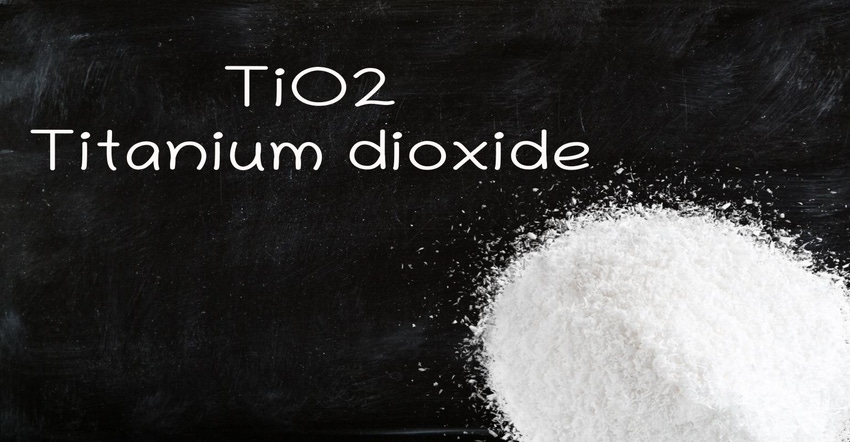Titanium dioxide ban: Five takeaways for U.S. supplement companies
Reckitt's Russell (Russ) Michelson reviews the hubbub surrounding titanium dioxide, including state legislation proposing to ban the ingredient, related class-action litigation and an FDA petition.
October 6, 2023

Do you remember back in 2014 when Fireball was pulled from the shelves of several European markets because it contained levels of an ingredient (propylene glycol) that was fully compliant in the U.S., but over the limit for Europe? I recall reading the concern and outrage from certain outlets clamoring for more food safety in the U.S. and the perception that “Europe does it better.”
Fast forward almost 10 years, and I see titanium dioxide (TiO2) as a perfect representation of that exact sentiment and the evolving global food safety landscape. State legislators and litigators are looking directly at Europe for inspiration on their next move. They work much faster than the U.S. Food and Drug Administration (FDA), with just as much, if not more, impact.
Reformulation of these scrutinized food additives is a much larger and more complex undertaking than policymakers anticipate, but signals across the TiO2 narrative may help industry stay ahead of policies and risks before they land on our doorstep here in the U.S.
To highlight the point, did you know it took just about six months from the 2022 announcement of the European ban on TiO2 before the first related U.S. lawsuit was announced? And only about six months later the first of three state bills—that being California—was proposed to ban the sale of all foods containing TiO2?
The timeline to comply with new regulations is shortening, and it’s not always going to be FDA setting all the rules for our industry. With a bit more of a global lens, and some insight on where to look, we can be prepared for whatever the next “titanium dioxide” may be.
5 key aspects of titanium dioxide story
#1 State legislation
We start with what was the most imminent factor in this story, California Assembly Bill AB-418, which, when introduced earlier this year, sought to ban the sale of all foods containing TiO2 by January 2025. However, you likely know this bill has just recently removed TiO2 from the language going forward.
On Sept. 19, the final bill passed by the legislature was presented to Gov. Gavin Newsom. If signed by Newsom, the bill will ban the manufacturing, distribution and sale of four ingredients in food products: brominated vegetable oil, potassium bromate, propylparaben and red dye 3.
The removal of TiO2 from the bill is no small feat by industry and those of us who saw the patterns arising out of Europe and were able to provide sound and influential data to the state legislature to emphasize the impact and safety of the use of this ingredient.
This bill was drafted in direct response to the ban in Europe and continued to pass almost unanimously through the state legislature. A similar California bill, AB-496, again based almost entirely on the European regulatory environment, has also been passing through the legislature with almost unanimous “ayes.”
AB-496 seeks to ban dozens of cosmetics chemicals for use in the state of California. These bills are proceeding quickly and being received favorably, so an early advocacy strategy is imperative if industry intends to challenge any of the details of a proposed bill.
And let’s not forget that both New Jersey and New York drafted legislation in 2023 that effectively aimed to ban the sale of all food containing TiO2 (and the same four chemicals as in California bill AB-418) by 2025 or sooner. They were practically copies of California bill, and were also, essentially completely based on the decisions in Europe.
As of now, while AB-418 sits on Newsom’s desk, both New Jersey and New York have stalled in their respective legislative processes, but it’s possible legislators will reintroduce such bills by early 2024. And California may do the same with a standalone TiO2 bill for all we know.
If these bills don’t strike TiO2 from their language, and if they don’t push out the compliance date by two or more years the way California had initially done, that leaves just an 18-month window to completely evaluate, reformulate and re-supply affected products. You’ll read later why that is generally unfeasible, depending on certain factors.
I agree we should not be using an ingredient like TiO2 or advocating to keep it on the market (outside of a reasonable transition period) if emerging science clearly indicates it is no longer safe for its intended use.
However, in the case of the European Food Safety Authority’s evaluation of TiO2, EFSA takes a precautionary hazard-based approach rather than the more common risk-based approach. Many other scientific and regulatory authorities disagree with EFSA’s conclusion and continue to permit the safe use of the ingredient.
This distinction means there is room for regulatory and scientific interpretation and therefore policy, advocacy and data become a time-sensitive and critical matter. This factor played an enormous role in how food and supplement companies influenced the California bill first to extend the compliance date and then to eventually remove TiO2 from the language altogether.
#2 Class-action litigation
Class-action threats are never off the table in California. As I mentioned above, the TiO2 ban in Europe was followed by several class-action threats—mostly out of California and Illinois—aimed at food, drug and supplement companies.
Demand letters and lawsuits can emerge much more swiftly than any legislative or regulatory action. While most, if not all, of these legal threats ended up either being dismissed, or simply faded away from media attention, all of us in the industry know they are disruptive to companies.
Whether you fight back, settle or simply ignore a legal demand, it does create internal uncertainty, discussions, action plans, and likely a bit of frustration as well. These cases also tend to generate some media attention, as you saw with the 2022 lawsuits involving TiO2, which can immediately have deleterious impact to your brand—whether the allegations are valid or not.
In conclusion, while state laws banning TiO2 may not be the imminent threat they were earlier this summer, legal threats may still linger around this ingredient. The outcome of an FDA review of this ingredient in response to a petition (see below), as well as the pending status of the three state bills, could open the door to additional class-action lawsuits in the short and long term.
#3 FDA petition
Yes, FDA is in the TiO2 game thanks to a petition filed by several consumer protection organizations. But as mentioned earlier, there is due process when considering revoking a regulation, and it’s much more orderly and time-consuming than what states can execute.
Many experts find it unlikely that FDA will grant the petition and repeal the color additive regulation providing for the use of titanium dioxide in foods. FDA previously said it disagrees with EFSA’s conclusion, which is in line with several other regulators around the world, including the U.K. and Canada.
FDA regulation already stipulates a 1%-by-weight usage level, which helps further ensure the safe use of the ingredient across industries. But FDA will have to take the petition seriously. Based on the original Federal Register filing, there are nearly 3,000 views of the petition (I swear those are not all me!). While this filing has only led to about 30 public comments, many of those comments are from organizations that represent dozens or even hundreds of companies.
The comment period has now closed. However, I do recommend keeping an eye on what FDA now does with this petition and how that impacts both the state legislation as well as the class-action environment.
#4 Reformulation complexity
A crude review of the public dietary supplement databases (the Council for Responsible Nutrition’s Supplement OWL and National Institutes of Health’s Dietary Supplement Label Database) suggests that about 7-10% of the products on the market utilize TiO2. This would place the total number of potentially impacted products anywhere between 3,500 to 8,000 (based on the estimate commonly given of between 50,000 to 80,000 supplement products in the U.S.).
Believe it or not, there’s a reason this ingredient is found in thousands of supplements in the U.S., not to mention the number of food and drug products. TiO2 is quite unique in what it does as a whitener, and there hasn’t historically been a ton of innovation toward developing competing ingredients.
That innovation has picked up since the ban in Europe was announced, but there isn’t a huge supply of TiO2 alternatives, and product development experts (with more expertise than me) note that reformulating around this ingredient is not as simple as one might think. Even with new innovations in this space, most replacements are still not exactly a 1:1 solution. And this information was shared with state legislators, who currently believe reformulation is simple and precise.
The true length of time for total reformulation and replacement depends on a variety of factors, including the number of impacted product formulations in your company, different dosage forms, manufacturing sites to coordinate across, ingredient suppliers and label components to update.
Other factors include the impact to the cost of a reformulated product, how the reformulated product looks compared to the original, and whether one needs to re-run stability studies to identify spotting or discoloration trends. And of course, removing TiO2 might produce a blotchy, spotty and discolored product that, while fully compliant, is wholly unappealing to most consumers. This work entails not just manufacturing a reformulated product but replacing it on retail shelves by compliance dates set by state legislators, provided any bill banning TiO2 is passed in the coming years. Depending on your portfolio size, you may need three years or more to get everything remediated.
In summary, when looking at keeping your company compliant, the complexity and timing of reformulation is an enormous factor. With states moving to ban this ingredient and recommending even shorter compliance timelines than before, giving yourself enough time to complete the above work is imperative. I recommend remaining aware of the signals and patterns emerging from international markets because they help provide a significantly longer runway toward maintaining long-term compliance.
#5: The signals
I will not be predicting the future of the next food additive to face global scrutiny. I don’t care what my father believes, I am not clairvoyant. But there are lessons you can glean from the TiO2 storyline and parallels to recent European and international activity that may prove to be highly predictive for us here in the U.S. Having them on your radar should (or at least may) help keep your organization ahead of the state activity that caught many by surprise this year.
With EFSA squarely at the center of influence on U.S. state legislation in recent years, this agency of the European Union is probably the first place you should be considering as a predictive measure.
For example, did you know EFSA just re-reviewed the safety of calcium carbonate for use in infant foods? While the agency essentially deemed it safe for use, certain details around intake level data in food supplements and heavy metal risk are still being addressed by the local industry associations. Calcium carbonate may be in the clear, for now, but the fact that EFSA re-evaluated it is still something for us to monitor.
Another interesting and very recent signal is a parallel to the French study on TiO2 from 2017 that essentially sparked this entire storyline—way before EFSA stepped in. That study led to the French authority investigation that led to the ban, which has now spread across almost 40 countries.
My ears recently perked up when I read a large prospective cohort study out of—you guessed it—France. This study explored dozens of common celluloses and emulsifiers and their potential impact on cardiovascular disease, and it concluded with a suggested association that warrants further exploration.
I will not go so far as to say the study will lead to regulatory changes, but I couldn’t help but think, “What influence will this study have on the French health authority activity in the coming years?” And how will it impact EFSA or JECFA (Joint FAO/WHO Expert Committee on Food Additives) after that? From a global policy and formulation strategy standpoint, I would rather have an inkling of a signal now and strategize accordingly.
These studies almost always start in conventional food use, which often affect supplements (regulated in the U.S. by FDA under the “umbrella” of foods). Food use of these ingredients is generally significantly higher than in supplements (grams vs. milligrams). Thus, the consumption and safety profile may vary between categories, but the policy will start based on food consumption. This is where researching and providing global food supplement usage data specifically can be influential, particularly regarding JECFA evaluations. Having international awareness, or connections to global organizations like IADSA (International Alliance of Dietary/Food Supplement Associations), can be critical to getting the food supplement sector’s voice at the table.
JECFA, a partnership between the UN’s Food and Agriculture Organization (FAO) and the World Health Organization, is currently reviewing TiO2 data received earlier this year, and it expects to draw a conclusion in the first half of 2024.
Additionally, JECFA is about to gather data on silicon dioxide and, in general, spend time re-evaluating the science and safety of food additives and updating its Codex General Standard for Food Additives (GSFA). This database is a significant resource for international authorities around the safe and compliant use of hundreds of food additive ingredients.
Conclusion
If you’re not currently worried about TiO2, I don’t blame you. But that doesn’t mean this storyline shouldn’t still matter to you. Whether it’s TiO2 or any other ingredient commonly used in dietary supplement products, what’s happening around the world now may be landing on your doorstep sooner than you’re used to.
Finally, it’s crucial that manufacturers and marketers of health products remain vigilant in tracking the science and regulatory developments of food ingredients around the world. The TiO2 saga underscores such global developments could be key indicators of future state and federal regulatory actions in the U.S.
About the Author(s)
You May Also Like






.png?width=800&auto=webp&quality=80&disable=upscale)